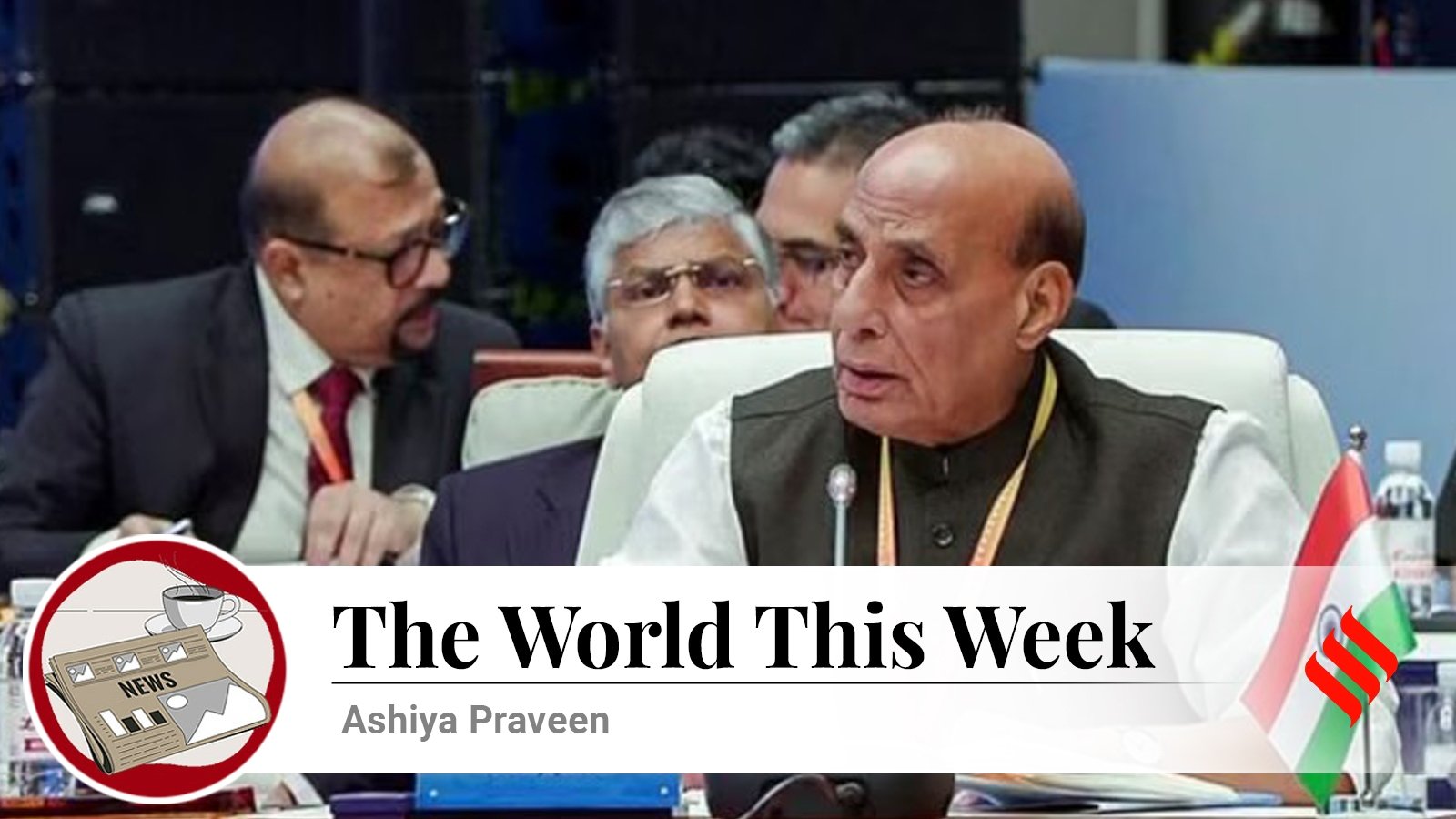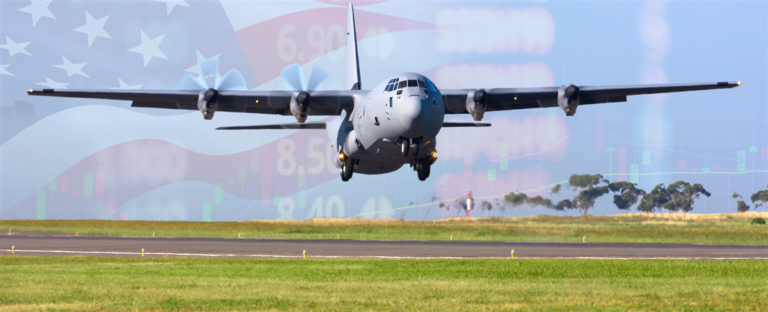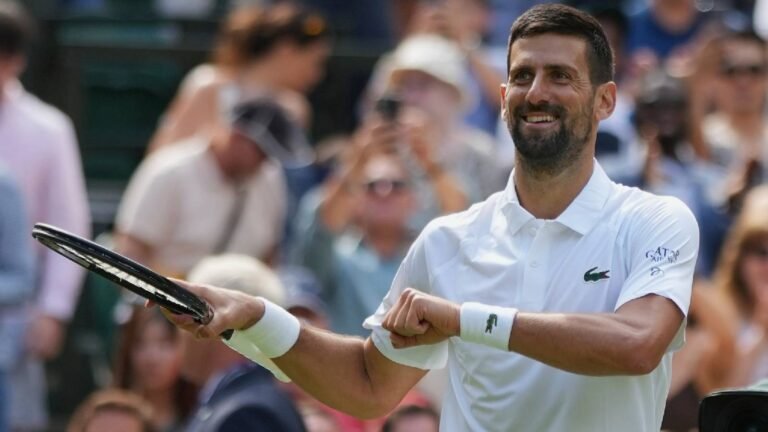
India refuses to sign draft statement at SCO meet over silence on the Pahalgam terror attack; uncertainty looms large over West Asia as Iran hints at suspending cooperation with the IAEA amid fragile ceasefire with Israel; Trump claims a ceasefire in Gaza could be reached within a week; NATO leaders agreed to raise defence spending to 5 per cent; India holds a final round of talks with the US before the July 9 deadline; Rwanda and Congo sign a peace deal – here is weekly roundup of key global news.
Objecting to the absence of a common standard for terrorism, Defence Minister Rajnath Singh refused to sign the draft statement of the Shanghai Cooperation Organisation (SCO) as it omitted a reference to the April 22 Pahalgam terror attack in Jammu and Kashmir but mentioned “disturbances in Balochistan”.
The failure to issue a joint statement after the Defence Ministers’ meeting in Qingdao, China from June 25 to 27 doesn’t bode well for the 10-member group. The joint statement, which was silent on the Pahalgam attack, nonetheless, mentioned the Balochistan Liberation Army’s hijacking of the Jaffar Express in Pakistan.
Although the SCO is largely invested towards its founders (China, Russia, and Central Asian states), leaving out the reference to the Pahalgam attack is largely seen against the renewed momentum in India-China relations after the 2020 border standoff, and the SCO chair held by China for 2025.
Moreover, the SCO was established in 2001 to enhance regional cooperation on terrorism, and its founding Charter in 2002 underscored the need to build “mutual intraregional efforts to curb terrorism, separatism and extremism”.
Defence Minister Singh underlined that as the world faces an intricate web of challenges, including transnational terrorism, cyber-attacks, hybrid warfare, and other non-traditional security challenges, which do not respect national boundaries, a unified response rooted in transparency, mutual trust and collaboration is needed to address such threats.
Since SCO member countries inhabit about 40 per cent of the world’s population and contribute around 30 per cent of the global GDP, the creation of a safe, secure and stable region is a collective stake, he added.
Story continues below this ad
The meeting of the SCO Defence Ministers took place weeks after Operation Sindoor which India launched on May 7 in response to the terrorist attack in Pahalgam and struck terror targets in Pakistan and Pakistan-Occupied Kashmir (PoK). Since then, India took its fight against terrorism global and sent parliamentary delegations to 32 countries, but it did not include any SCO member-country.
On the sidelines of the SCO meet, Singh also held bilateral meetings with his Russian and Chinese counterparts, Andrey Belousov and Admiral Dong Jun. Now the attention will be shifted to the SCO Foreign Ministers’ meet in July and the SCO Summit in August-September to see how India’s concerns are addressed. Amid all this, the broader geopolitical landscape remains tense.
Israel-Iran ceasefire holds, but uncertainty remains
While a tenuous ceasefire between Israel and Iran holds after 12 days of war, uncertainty looms large over the ever-volatile region of West Asia, with Iran hinting at suspending cooperation with the UN nuclear watchdog and US President Donald Trump asserting he would “absolutely” consider fresh attacks to curb Tehran’s nuclear weapons programme.
But a serious concern remains the assessment of damages caused by the US attack on Iran’s three nuclear sites – Fordow, Natanz, and Isfahan – especially amidst contradictory claims. Preliminary assessments suggested that Operation Midnight Hammer did not destroy Iran’s nuclear capabilities and only set it back by a few months, contradicting Trump’s claim that the three sites were “obliterated” and the programme was set back by decades.
Story continues below this ad
However, Iran on Wednesday (June 25) for the first time acknowledged that US strikes “badly damaged” its nuclear installations. “Our nuclear installations have been badly damaged, that’s for sure,” Bloomberg cited Foreign Ministry spokesperson Esmail Baghaei as saying during an interview with Al Jazeera TV.
He called the US attacks a “detrimental blow” to international law and the nuclear Non-Proliferation Treaty to which Iran is a signatory. Iran has also approved a Bill to suspend cooperation with the International Atomic Energy Agency (IAEA), according to Al Jazeera.
It raises concerns over the status of Iran’s 400 kg of enriched uranium — enough material for nearly 10 nuclear bombs — or the condition of its advanced centrifuges, which IAEA inspectors could ascertain if Iran allows them.
However, despite being aware of the lack of balance of power, Iran’s battle-hardened leadership is unlikely to back down. Supreme Leader Ayatollah Ali Khamenei even claimed Tehran won its recent 12-day war with Israel.
Story continues below this ad
Iranian-American academic Vali Nasr also argues that since Iran is locked in a battle for survival with Israel and the US, it is unlikely to capitulate and would possibly seek to acquire nuclear weapons as a measure of deterrence.
During the 12-day war, Iran’s sustained retaliatory attacks against Israel not only exposed vulnerabilities in its vaunted multilayered air defence system but also demonstrated the futility of war in either dismantling its nuclear programme or imposing regime change.
The situation turns the spotlight back to diplomacy. But it will not be easier to bring Iran back to the negotiating table as the war has wedged deeper distrust and hardened the positions on both sides.
Trump claims Gaza ceasefire possible
In the meanwhile, amid growing condemnation of Israel’s horrific war in Gaza and continued killing of starving Palestinians near aid sites, US President Trump claimed a ceasefire between Israel and Hamas could be reached within a week.
Story continues below this ad
Gaza’s Government Media Office says revelations in the Israeli media that soldiers were ordered to “deliberately shoot” starving Palestinians seeking aid supplies are further evidence of “war crimes” in Gaza, Al Jazeera reported.
Israeli Prime Minister Benjamin Netanyahu and Defence Minister Israel Katz have rejected the report of commanders targeting civilians. But Gaza’s Health Ministry has reported that almost 550 Palestinians have been killed near aid sites operated by the US- and Israel-backed Gaza Humanitarian Foundation (GHF) since Israel partially lifted its total blockade on the strip in late May.
The head of the UN agency for Palestinian refugees (UNRWA) Philippe Lazzarini says GHF aid distribution sites created “a killing field”. This view was echoed by the Director of the Council for Arab-British Understanding, Chris Doyle, as he told Al Jazeera that food distribution centres are “death traps”. He also stressed that UN agencies and humanitarian groups have for months warned that operations by the GHF were “utterly wrong and unworkable”.
Meanwhile, ongoing restrictions on the entry of essential medical supplies and fuel have compounded the health crisis in Gaza, the UNRWA has said. According to Gaza’s Health Ministry, Israel’s war on Gaza has killed at least 56,331 people and wounded 132,632. An estimated 1,139 people were killed in Israel during the October 7 attacks, and more than 200 were taken captive.
Story continues below this ad
Al Jazeera’s Nour Odeh, reporting from Amman in Jordan, also said that talk of a “ceasefire in Gaza increased exponentially after the ceasefire between Israel and Iran. Israel does not want to talk about ending the war. In fact, the Israeli prime minister would be risking a lot if he did.”
But, she added, there is an understanding, according to many reports, that Netanyahu would have to agree to some sort of ceasefire in exchange for normalisation deals with Arab states, which the Trump administration has promoted.
Hamas, on the other hand, requires that Israel stop its war on Gaza and that the Israeli military withdraw from areas it seized in Gaza after breaking the last ceasefire in March. “Hamas also wants US guarantees that negotiations would continue and that Israel wouldn’t break the ceasefire again if more time was needed for negotiations,” Odeh added.
NATO leaders agree to hike military spending
Amid pressure from US President Trump and his stance on the Russia-Ukraine war, NATO leaders agreed to raise defence spending to 5 per cent of their countries’ economic output by 2035 and expressed their “ironclad commitment” to come to each other’s aid if attacked.
Story continues below this ad
The 32 leaders of member countries endorsed the final summit statement saying: “Allies commit to invest 5 per cent of GDP annually on core defence requirements as well as defence- and security-related spending by 2035 to ensure our individual and collective obligations.”
However, Spain, which had allocated 1.24 per cent of its GDP in 2024 to defence spending, announced it would not adhere to this target, earning Trump’s ire and the potential for Spain-specific trade sanctions. The summit was held in The Hague, the Netherlands on 24-25 June.
The “One for All, All for One” principle mentioned in Article 5 constitutes the bedrock of NATO’s existence. It says an attack against even one of the members would be considered an attack against all members.
NATO was founded by 12 Western countries in 1949 to resist the threat from the communist Soviet Union. NATO’s first secretary-general, Lord Ismay, famously declared its goal: “To keep the Americans in, the Russians out, and the Germans down.” C. Raja Mohan argues that in the post-War order, this formula made sense, but the present moment demands a very different configuration.
Story continues below this ad
The reversal of decades-long animosity between the US and Russia has largely upended NATO’s stance towards Ukraine. Since 2022, every NATO summit has committed to aiding Ukraine in its war against Russia. Most NATO countries view Russia as a direct and immediate threat.
But Trump has paused US military aid to Ukraine in its war against Russia and has ruled out the possibility of Ukraine joining NATO. C. Raja Mohan argues as Trump rethinks US relations with Russia and China, major powers in Europe and Asia will have to rethink their great power relations and look beyond the US security alliances.
This recalibration of global power equations coincides with India and the US seeking to finalise a trade agreement.
India, US hold final round of trade talks
As the July 9 deadline for the reciprocal tariff pause is just days away, Indian trade negotiators are in the US to hold final negotiations for a trade deal. However, market access in agriculture and other sensitive areas remains key sticking points.
President Donald Trump on June 26 said the US and India may sign a “very big” deal “where we’re going to open up India”. According to a person privy to the development, India is likely to face more pressure to accept US demands to avoid reciprocal tariffs.
The US and India held the last round of talks earlier this month, which yielded little progress. The two sides are at loggerheads over the US’s demand seeking increased market access for its agricultural products, especially soya and corn.
Agricultural goods receive high protection in India and have largely remained outside trade agreements. India primarily exports basmati rice, spices, cereals, dairy, and poultry products to the US. Amid the ongoing trade talks, there were reported concerns among some domestic agricultural-based industries about the possible concessions that the deal might entail, especially those related to genetically modified (GM) crops.
The US has also flagged a number of non-tariff barriers and high duties in India, but is yet to commit to several Indian demands. In addition to the elimination of the 26 per cent reciprocal tariff, India is seeking duty-free entry for labour-intensive export items such as textiles and footwear in the US.
At the same time, India has reduced tariffs on some items, including high-end motorcycles and automobiles, and some other electronics. Official trade data also shows that India’s import of crude oil from the US rose 11.49 per cent to $63 billion in March 2025 compared to the previous year.
In the meantime, Trump claimed that the US and China have signed a trade deal that will make it easier for American firms to obtain magnets and rare earth minerals from Beijing. “Part of the agreement was tariffs coming down and rare earth magnets starting to flow back to the US,” Treasury Secretary Scott Bessent said on Friday.
The same day, another significant political development was reported from Africa.
Rwanda, Congo sign peace deal
The Democratic Republic of Congo and Rwanda signed a peace agreement on Friday (June 27), raising hopes for an end to the worst fighting in decades that killed thousands and displaced hundreds of thousands.
The agreement, signed by the two African countries’ foreign ministers in Washington, DC, would see Rwandan troops withdraw from eastern Congo within 90 days, according to a copy seen by Reuters.
The peace deal is backed by the US and Qatar, and came after a series of talks that followed a meeting between the governments of Congo and Rwanda in March in Doha, Al Jazeera cited a Qatari diplomat as saying.
The talks were held amid offensives by Rwanda-backed M23 fighters in which they captured eastern Congo’s two largest cities – Goma and Bukavu – and lucrative mining areas earlier this year.
The gains by M23 were the latest cycle in a decades-old conflict with roots in the 1994 Rwandan genocide. Eastern Congo, on the other hand, has been experiencing the worst conflict since the Second Congo War (1998–2003).
The Democratic Republic of Congo, formerly known as Zaire (from 1971 to 1997), is a vast, resource-rich country with an estimated $24 trillion in untapped mineral deposits. US President Trump said, “We’re getting, for the United States, a lot of the mineral rights from the Congo as part of it,” Reuters reported.
Send your feedback and ideas to ashiya.parveen@indianexpress.com.





